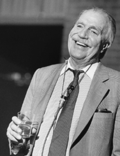Redesigning 2

Ian McHarg
Ian McHarg ( November 20, 1920-March 5, 2001 ) was a landscape architect and the founder of the Department of Landscape Architecture at the University of Pennsylvania. His 1969 book Design with Nature pioneered the concept of ecological planning. It continues to be one of the most widely celebrated books on landscape architecture and land-use planning. In this book, he sets forth the basic concepts (including the “environmental overlay” method) that would later form the basis for Geographic Information Systems. It was in his hometown of Glasgow that he gained an appreciation of the need for cities to better accommodate the qualities of the natural environment, which had been largely shunned. After the war he traveled to America to attend Harvard University where he received his professional degrees in both landscape architecture and city planning. From here McHarg began teaching at the University of Pennsylvania, where he developed the Department of Landscape Architecture, as well as offering a new course titled “Man and Environment” (Penn. Gazette, 1). His accomplishments escalated after this point. In 1960, he hosted his own show on CBS, “The House We Live In.” In 1969, he published his book Design with Nature, which was essentially step-by-step instructions on how to break down a region into its appropriate uses (Wenz, 2). McHarg said about his book:
This book is a personal testament to the power of sun, moon, and stars, the changing seasons, seedtime and harvest, clouds, rain and rivers, the oceans and the forests, the creatures and the herbs. They are with us now, co-tenants of the phenomenal universe, participating in that timeless yearning that is evolution, vivid expressions of time past, essential partners in survival and with us now involved in the creation of the future (Corbett, 2). Our eyes do not divide us from the world, but unite us with it. Let this be known to be true. Let us then abandon the simplicity of separation and give unity its due. Let us abandon the self mutilation which has been our way and give expression to the potential harmony of man-nature. The world is abundant; we require only a deference born of understanding to fulfill man’s promise. Man is that uniquely conscious creature who can perceive and express. He must become the steward of the biosphere. To do this he must design with nature (Corbett, 2).
Design with nature is sharply critical of the French style of garden design, which McHarg saw as a subjugation of nature, and full of praise for the English style of garden design, which McHarg saw as a prototype for his ‘design with nature’ philosophy. McHarg’s own plans for urban expansion projects were more ‘English’ than ‘French’ in their plan geometry. He favored what became known as ‘cluster development’ with relatively dense housing in a natural environment. McHarg was also interested in garden design and believed that homes should be planned and designed with good private garden space.To understand McHarg’s work, one must look at what site-design too often means in practice even 30 years after McHarg’s efforts began: design means restructuring sites to suit a client’s ego, a designer’s whimsy, a contractor’s convenience, and the dictates of financiers and lawyers. The belief that nothing in nature should constrain what humans do to the land they “own” is the ultimate hubris – which McHarg attempted to change. McHarg was “fierce,” to use his own word, about respecting ecosystems – which made him a star, but sometimes undermined him. His status as one of landscape architecture’s few celebrities, however, warrants neither blind adulation nor blindered attack.
This book is a personal testament to the power of sun, moon, and stars, the changing seasons, seedtime and harvest, clouds, rain and rivers, the oceans and the forests, the creatures and the herbs. They are with us now, co-tenants of the phenomenal universe, participating in that timeless yearning that is evolution, vivid expressions of time past, essential partners in survival and with us now involved in the creation of the future (Corbett, 2). Our eyes do not divide us from the world, but unite us with it. Let this be known to be true. Let us then abandon the simplicity of separation and give unity its due. Let us abandon the self mutilation which has been our way and give expression to the potential harmony of man-nature. The world is abundant; we require only a deference born of understanding to fulfill man’s promise. Man is that uniquely conscious creature who can perceive and express. He must become the steward of the biosphere. To do this he must design with nature (Corbett, 2).
Design with nature is sharply critical of the French style of garden design, which McHarg saw as a subjugation of nature, and full of praise for the English style of garden design, which McHarg saw as a prototype for his ‘design with nature’ philosophy. McHarg’s own plans for urban expansion projects were more ‘English’ than ‘French’ in their plan geometry. He favored what became known as ‘cluster development’ with relatively dense housing in a natural environment. McHarg was also interested in garden design and believed that homes should be planned and designed with good private garden space.To understand McHarg’s work, one must look at what site-design too often means in practice even 30 years after McHarg’s efforts began: design means restructuring sites to suit a client’s ego, a designer’s whimsy, a contractor’s convenience, and the dictates of financiers and lawyers. The belief that nothing in nature should constrain what humans do to the land they “own” is the ultimate hubris – which McHarg attempted to change. McHarg was “fierce,” to use his own word, about respecting ecosystems – which made him a star, but sometimes undermined him. His status as one of landscape architecture’s few celebrities, however, warrants neither blind adulation nor blindered attack.
McHarg’s contribution encompassed three important values: 1. recognition that geographic and demographic patterns could be mapped in ways that make the designer’s eye a tool for visual analysis. 2. advocacy for the land itself, in the face of a culture that insists landscapes are just another consumable commodity. 3. refusal to accept that landscape architecture should be subservient to architecture or engineering. These concepts permeate today’s design professions – to our great benefit – and are taken for granted. GIS has made overlay analysis standard, often misconstrued as a hyper-rational, mechanistic tool. Critics need to consider how much “lack of holism” comes from the tool, and how much from those who mis-use it.
McHarg intended all analysis as a first step – a platform on which to base creative design, not the cold planning algorithm that some of his technical followers occasionally make it. Yes, McHarg often failed to push beyond planning and to achieve the aesthetic, poetic, holistic design he personally most admired. A major reason was that he had to fight our culture’s accumulated hubris to get ecology onto the table at all. In some ways, that only makes his contribution more remarkable. [edited excerpt from Landscape Architecture Magazine, letters page, 2006; submitted by the author and copyright-holder, Kim Sorvig, Contributing Editor, Landscape Architecture]
Biography from Center for Spatially Integrated Social Science John Corbett 2005
Obituary at Pennsylvania Gazette
Book review of Design with Nature from Ecotecture Philip Wenz 2003 http://digitalstudio.gre.ac.uk/content/view/112/58/From-Wikipedia
Peter Gluck, another Design Social Entrepreneur or Social Inventor
Book review of Design with Nature from Ecotecture Philip Wenz 2003 http://digitalstudio.gre.ac.uk/content/view/112/58/From-Wikipedia

Peter Gluck, another Design Social Entrepreneur or Social Inventor
